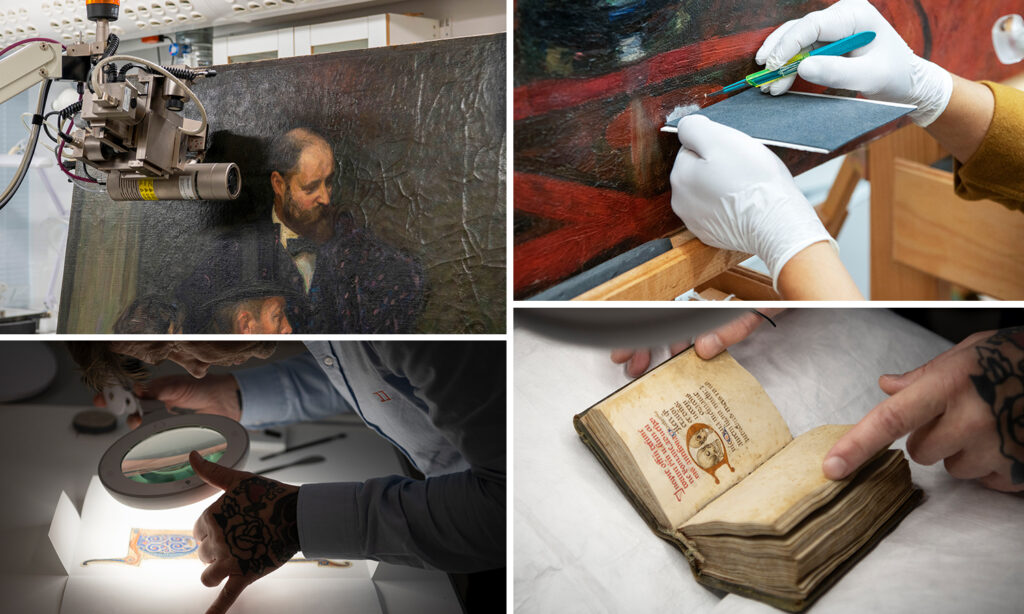
Heritage Laboratory
The Heritage Laboratory of the Swedish National Heritage Board is a central facility for the development and application of heritage science, including conservation science, archaeometry and art historical research.
As a national laboratory resource we foster implementation of best practice and collaboration on a national and international level. We use experimental and analytical techniques to examine, document and identify materials and to study their ageing and working properties. Our investigations may extend from minute fragments of objects or single materials to entire collections, buildings, sites and landscapes.
Research and Development
Our staff of advisors consists of heritage scientists and a broad base of expertise in such varied areas as architecture and engineering to biology and the cultural environment. We conduct and participate in research and development projects, ranging from single-day visits by guest colleagues to multi-year international engagements, rather than assignments on an individual charge basis. We host guest colleagues on a regular basis. This popular format lets us solve heritage science queries in an open and cooperative manner. We value international projects and invite collaboration involving specific problems or areas of interest, and the establishment of networks or programmes to further the exchange of knowledge. We specifically support research projects with a focus on conservation science.
Our prioritized areas include:
- architectural paint research
- poisonous and hazardous substances in collections
- modern materials research
- methods and solutions for conservation
- collections management and care
Facilities
The Heritage Laboratory is geared towards flexibility to accommodate different projects and meetings. In order to ensure a high level of quality for analyses and documentation we work according to good laboratory practice (GLP). All laboratory spaces have particle filtered clean air and are fully climate controlled at 50 % ±5 % relative humidity and 21 °C ± 3 °C. A separate space for mechanical material analysis is available, permitting even more stringent climate control. Many of the analytical and monitoring instruments are portable and also allow for non-invasive analyses.
- mobile high resolution digital X-ray
- variable pressure scanning electron microscopy with energy dispersive X-ray spectroscopy (VP-SEM/EDS)
- stereomicroscopy with UV/vis/pol
- Fourier transform infrared spectroscopy (FTIR) with attenuated total reflectance (ATR), microscopy, mapping and imaging capabilities
- X-ray fluorescence spectroscopy (XRF) with micro-spot and mapping solutions
- advanced imaging documentation including reflectance transformation imaging (RTI), spectrophotometry, colourimetry and micro-fadometry
- instruments for climate measurement
- equipment for accelerated ageing tests including a climate chamber and metal-halide lamp
- tensile and compression testing
Conservation equipment for a variety of purposes, including freeze drying, large-scale freezing down to -30 °C, air abrasion, desalination, vacuum and anoxia packing, is also available for research and development. The Heritage Laboratory also has archival space for reference collections consisting of paint, pigment and other material samples, as well as short term secure storage spaces with adjustable climate control.
About the Department for Heritage Development
The Heritage Laboratory is a part of the Department for Heritage Development at the Swedish National Heritage Board. The department is situated in Visby and works as a national coordinator in matters relating to the conservation and the science of cultural heritage. Responsibilities include the dissemination of information and providing of advice and support to professional networks. Involvement encompasses research and development concerning the care and management of historic landscapes and environments, buildings, ancient monuments, collections, objects and materials in order to advance preservation, accessibility and the sustainable management of cultural heritage.
We work with many partners from both the private and public sectors including museums, universities, libraries, government or council authorities and others responsible for the management of cultural heritage and Environments. The Department for Heritage Development has special responsibilities in the following areas:
- Built environments and listed architecture
- Climate change and sustainable management
- Collections management
- Public art
- Rune stones
- Historic landscapes
- European Committee for Standardization (CEN)